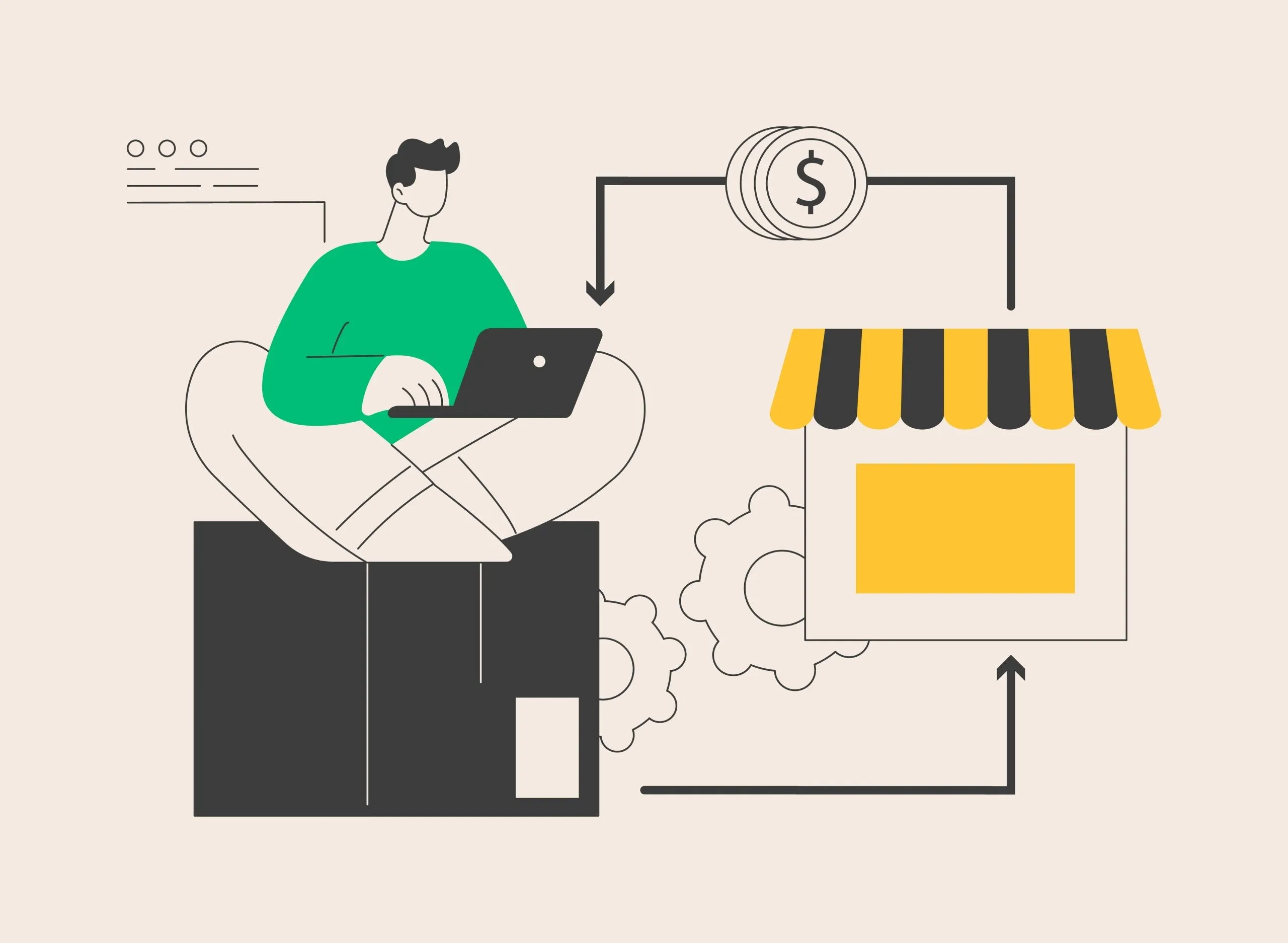E-commerce has become a rising business model for many reasons such as the increasing supply-demand relationship, the costs of opening a physical store, the goals of businesses to increase brand awareness for their existing brands, the variety of products created for a need, and the increasing number of entrepreneurial individuals who want to do their own business.
We know that selling products over the internet has many advantages. Reaching more potential customers than traditional trade, selling at any time of the day, selling products and services at low costs, even selling products without stock and without considering the cost of product storage and reducing personnel costs by employing a minimum number of personnel are just a few of the factors that make e-commerce attractive.
Selling over the internet is a very general expression. To start e-commerce, it is necessary to have the necessary resources and infrastructure services. It is necessary to know that e-commerce is a very comprehensive initiative, from creating an idea to choosing a product and opening to the market. So what is required to start e-commerce? Let’s take a look together.
1. Solve an existing problem or invent a product to start e-commerce
The most important and perhaps the most difficult part of starting trading is to find the product that will really sell by considering many aspects. To start e-commerce, you can start selling a product that is suitable for an existing problem, or you can choose to sell a product that does not have enough sellers but is in demand in the market, or you can invent a new product.
If the product you choose for e-commerce offers a solution to a problem, this may be the fastest way to move you up. Because finding a solution to a problem means reaching existing potential customers. On the other hand, inventing a product will also require creating demand for that product. You may need to be more patient for this second option. If you want to move a little faster, you can start by doing good market research and finding products that are in demand and already exist, but have insufficient service. For example, you can order quality products with the best price through sites such as Alibaba, eBay and Amazon as a result of good research, and start selling with or without stock.
2. Prepare your business plan before starting e-commerce, determine the framework of your business
Creating a good business plan to start e-commerce is very important to set your goals and plan your strategies. A good business plan should include the following topics;
Financial forecasts
You need to budget for the work you will do. The cost of the product you want to sell in e-commerce, storage costs, photo and video shooting costs reflecting the features of the product, personnel costs, if any, packaging costs of orders, marketing costs such as small gifts, business cards/thank you cards that you think your customers will like, website setup costs and shipping costs if you are going to create your own website and sell your products yourself, the commission costs of the marketplaces if you are going to sell your products from the marketplaces are the costs that you need to consider in the financial estimates budget.
Marketing strategy
A good e-commerce experience is directly proportional to a well-designed marketing strategy and the implementation of it.. Make sure that you explain the features, benefits and differentiating features of the product you want to e-commerce very well. Decide what your marketing tools will be and take steps for your needs. For example, design your brand logo and get domain names for your website and social media channels. Start preparing photo and video contents that best reflects your product.
Business structure
Before starting e-commerce, you should decide whether you want to start the business individually or in partnership.

3. Time to set up your own company to officially start e-commerce
You must take the necessary legal steps to legalise your business. To start e-commerce, you need to determine your business type, register your business name and make your tax registration.
You can have an official company within 1-2 business days with small establishment costs.
Don’t skip doing preliminary research for government incentives such as KOSGEB, which supports entrepreneurship.
4. Where will you sell your e-commerce product? In marketplaces or on your own website?

Step by step you are getting closer to receiving your first order. Isn’t it exciting? You have found the product you want to sell by e-commerce, made your business plan and established your company. Now it’s time to decide where you want to sell this product.
There seem to be endless options in the ever-increasing number of new e-commerce channels, and trying to choose the best place to sell products can be a daunting task.
Sellers who are new to e-commerce start selling on the marketplace or build their own website to ensure customer reach and brand awareness. It is also an option to start doing both at the same time.
What does it mean to sell on the marketplace?
Marketplace means a third-party sales platform that contains product listings of many sellers in product categories. If we give examples of marketplaces in Turkey and in the world; Trendyol, Hepsiburada, Yemeksepeti, Getir, Amazon, eBay, N11, Çiçeksepeti, Pazarama, Allegro, Zalando are marketplaces.
What does it mean to sell on your own website?
It is an e-commerce website independent of marketplaces, where buyers shop directly through your business website. If you want to engage in e-commerce without depending only on the marketplace, you should create a website for your business’s e-commerce permission. For this, you should choose a professional design and take care to make it user-friendly.
5. Know the difference between selling on marketplaces and your e-commerce website
There are key differences between selling on marketplaces and on your own e-commerce site. Make sure you are in the right marketplace for the product you are selling. For example, Amazon is one of the most preferred marketplaces due to factors such as the high number of visitors and the fact that it is the most preferred marketplace in Europe.
Thanks to marketplaces, you can reach millions of visitors, but you will struggle to be seen among thousands of sellers. Having an e-commerce website is one way to differentiate your business, but you will need to make a serious effort to increase visitor traffic and sales to your website.
Research the advantages of selling in marketplaces
Selling on marketplaces has many advantages. Find out why sellers use these platforms.
- Starting e-commerce on marketplaces makes e-commerce easier, especially for new sellers. Marketplaces have an existing infrastructure for e-commerce such as payment systems and cargo companies integration. In this way, sellers do not create an e-commerce website from scratch and thus save time and cost.
- Marketplaces are not owned by any individual seller. Therefore, the transactions and payments in the shopping process are carried out by the marketplace itself. The seller experience on these platforms consists of adding and modifying product listings and participating in campaigns offered by marketplaces.
- There are millions of potential buyers already shopping on marketplaces.
- Marketplaces are trusted websites for online shopping. Visitors don’thesitate when shopping online and are used to looking at marketplaces for the products they are looking for.
- Marketplaces are already known places. Since they have millions of customers looking for products similar to yours, you don’t need to spend much effort to get your products in front of potential buyers. If you use the advertising spaces in the marketplace, it will be even easier to meet your potential customers.
Research the disadvantages of selling in marketplaces
Selling on the marketplace may seem like a simple and easy option, but selling through a third-party sales channel to sell your products comes with some disadvantages.
- There are other sellers in the marketplaces selling the same or similar products as yours. Due to the large number of competitors, you may not get the product visibility and easy sales you expect due to the intensity of competition in the product category.
- Customers who buy your product may never realise that you exist as a brand. Because even if the customers who shop from marketplaces buy your product, they will often remember the marketplace, not your brand, in their next purchases. This is because the focus of marketplaces is on products, not sellers. Marketplaces have very restrictive customisation areas for brands and this makes it difficult for customers to remember your brand.
- You can’t create your customer database on marketplaces to market for customers who buy products from your brand. Marketplaces don’t allow sellers to communicate with their buyers outside of their platform. Therefore, you can’t inform your customers about your promotions, new products or special discounts.
- Marketplaces receive commissions for listing your products and for sales made through the platform. The commission rates of marketplaces may vary according to the product category. For example, the commission rate in the jewellery category may be higher or lower than the commission rate in the textile category.
Research the advantages of having your own website for e-commerce
There are many advantages to creating your own e-commerce website.
- You are the sole authority on all matters of your brand. From the design of your website to product placements, from listing formats to content texts, from price to campaign diversity, you are in control. In the design of your website, you have options that will best reflect your products and show your brand’s identity in the best way.
- You provide your customers with the shopping experience you determine. You can freely choose the most suitable template among many e-commerce platform designs.
- You can keep in touch with your customers who shop on your website to become your customers again and reach them directly. Since you can reach your customers directly, you can leave positive impressions on them to shop from you again with better customer service.
- By targeting people who visit your website even if they haven’t shopped from your website, you can attract them back to your website and make them shop.
Research the disadvantages of having your own website for e-commerce
If you plan to sell only through your own website for e-commerce, you should not ignore the disadvantages of this.
- Buying a domain name and hosting service, setting up a shopping cart and credit card payment infrastructure, and creating the visual and textual content of the products for product listing on the website are essential for setting up an e-commerce website. E-commerce platforms and ready-made template tools can make some processes easier for you, but there will still be necessary work to ensure the technical setup and sustainability of an e-commerce website.
- You have technically set up your website and made it very suitable for shopping. Opening your website doesn’t mean that your work is over. You need to create traffic to your website and attract shoppers to your site. It won’t be easy for visitors to come to your website spontaneously. You will need to learn to use the right marketing tools to drive traffic to your website and allocate a budget for marketing.
- When customers come to your website, you need to provide a smooth customer experience in stages such as welcoming them, examining the products while browsing your website, and payment steps. If you dont provide these, all the effort you have spent for them to visit your website will be wasted. Negative user experience causes your potential customers to leave your website without buying anything.
Discover our content
In your e-commerce journey, with fiCommerce e-logistics services and technological solutions, we make your job easier by both setting up your website and making marketplace integrations and enabling you to follow your business on a single platform. Contact us, let’s offer the most accurate and fastest solutions for you.





